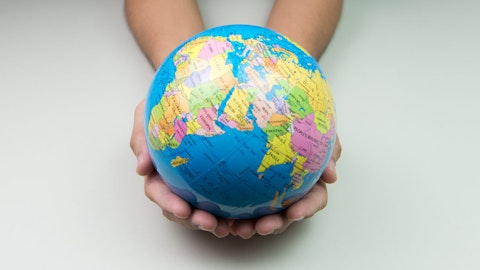In this article, we list and discuss the 30 Countries With The Highest Purchasing Power Parity in the World. If you would like to skip our detailed discussion of the topic, you can go directly to 10 Countries With The Highest Purchasing Power Parity in the World.
The world population is growing fast, and so is the global economy. Today, the global economy stands at $104.48 trillion, with the leading countries having Gross Domestic Product (GDP) figures as high as $27.97 trillion. But do these leading countries hold the same rankings and figures when their economic wealth is measured by purchasing power parity (PPP)?
Purchasing Power Parity (PPP) is a macroeconomic concept used to compare the relative value of currencies between different countries. When we say value, we mean how much purchasing a currency can do compared to different countries. So, to find that out, economists apply PPP, which is the exchange rate at which one country’s currency would be converted into another to purchase an identical basket of goods and services. The PPP metric is usually used to measure economic productivity and standards of living between countries.
For instance, a basket of goods and services can cost $100 in the United States, but only about $60 in China. That means the average person in China pays less than the average person in the US to buy the same goods and services. The product doesn’t change, but the difference in currency does, and that affects the quantity that can be purchased by both individuals. However, it’s important to note that it does not necessarily mean the average person in China is richer than the average person in the US. In fact, the US remains the world’s undisputed leader in private wealth creation and accumulation, with a whopping $67 trillion in liquid investable wealth, according to the report published by Henley & Partners.
Nonetheless, economists prefer PPP for comparing economic indicators like GDP between countries. When PPP is paired with Nominal GDP, which is the country’s output without accounting for inflation or price changes, we get a more accurate look at a country’s economic output or GDP (PPP). In other words, using purchasing power parity, a GDP is converted to a common baseline currency (International dollars), which helps in more accurately comparing countries and their global standpoints.
As of 2024, the Asia-Pacific (APAC) region has the highest GDP (PPP) in the world, contributing a whopping $84.82 trillion to the global economy. Meanwhile, the Pacific Islands and the Caribbean are the two regions with the lowest regional GDP (PPP) of $314 billion in total.
On the other hand, the companies that contribute the most to the global economy based on PPP include the leading corporations, such as Alibaba Group Holding Limited (NYSE:BABA), Tesla Inc (NASDAQ:TSLA), and Tesco Corp (NYSE:TESO).
In 2024, the global economy seems to be dented by the ongoing global conflicts on one of the key maritime trading gateway, the Red Sea. The Red Sea is a critical route for the freight market as it bridges the Mediterranean Sea and the Indian Ocean, which accounts for around 12% of global trade. However, due to Israel’s aggression on Palestinian territories, Houthis — the Yemeni militant group — have started attacking shipping vessels connected to Israel in an attempt to pressure world leaders to coerce them to take action and put an end to this aggression. Consequently, major shipping liners are opting for an alternate Cape of Good Hope route, which adds about 3,500 nautical miles to the journey. The Red Sea crisis has not only increased delays in cargo shipping but also hiked up the costs of shipping, which has increased the overall prices of goods.
Alibaba Group Holding Limited (NYSE:BABA) is a Chinese tech company that specializes in e-commerce and retail. With this threat to the global supply chain, the logistics arm of Alibaba Group Holding Limited (NYSE:BABA), Cainiao, will also be majorly impacted by longer delays in shipping to Europe.
Meanwhile, Tesla Inc (NASDAQ:TSLA), the king of the electric vehicle (EV) market, suspended its car production at its factory near Berlin for two weeks, from Jan 29 to Feb 11, due to the disruption in supply chains by the rising conflicts on the Red Sea. Concurrently, the shares of Tesla Inc (NASDAQ:TSLA) also declined by 2.9%.
On the other hand, Tesco Corp (NYSE:TESO) is also one of the leading multinational retailer companies in Europe to face major challenges due to the supply chain disruption caused by the attacks on the Red Sea. The CEO of Tesco Corp (NYSE:TESO), Ken Murphy, showed his concerns and said that if the shipments have to go the whole way around Africa to get to Europe, it will extend shipping times, constrain shipping space, drive up shipping cost, and that could drive inflation on some items. Experts predict that if the Red Sea crisis is not sorted out, Europe’s economy will suffer as it heavily depends on the Red Sea maritime route.
Below, we have listed the top countries with the highest purchasing power parity in the world today.

30 Countries With the Highest Purchasing Power Parity in the World
Our Methodology
For our list of the 30 Countries With The Highest Purchasing Power Parity in the World, we calculated the PPP using the GDP per capita by PPP of the fifty top countries with the largest economies in the world and their population. We then shortlisted the top 30 and compiled the list in ascending order. Our base data for GDP per capita and population has been sourced from the International Monetary Fund and the CIA’s database and is accurate to 2024.
By the way, Insider Monkey is an investing website that uses a consensus approach to identify the best stock picks of more than 900 hedge funds investing in US stocks. The website tracks the movement of corporate insiders and hedge funds. Our top 10 consensus stock picks of hedge funds outperformed the S&P 500 stock index by more than 140 percentage points over the last 10 years (see the details here). So, if you are looking for the best stock picks to buy, you can benefit from the wisdom of hedge funds and corporate insiders.
30 Countries With The Highest Purchasing Power Parity in the World
30. Netherlands
GDP (PPP): $1,319,225,272,200
Thirtieth on the list, the Netherlands is a small high-income European country, best known for its beautiful landscapes and tourist attractions like the Van Gogh Museum and Anne Frank’s House. As of 2023, the Netherlands had a population of only over 17 million people, but a GDP per capita by PPP of $75.54 thousand.
29. Malaysia
GDP (PPP): $1,336,974,423,250
Located in Southeast Asia, Malaysia is an upper-middle-income country as of 2024. According to the Australian Government’s Department of Foreign Affairs and Trade forecasts, Malaysia’s economy will have achieved the high-income (or developed) country status by 2040. As of 2024, the GDP per capita by PPP of the country stands at $39.07 thousand, and the overall GDP by PPP stands at about $1.33 trillion.
28. Philippines
GDP (PPP): $1,412,346,846,000
Ranked 28th, the Philippines has a GDP by purchasing power parity of over $1.4 trillion alongside a diversified and growing East Asian economy. The Philippines is a major semiconductor, ship-building, and electronics exporter, and the International Monetary Fund forecasts a change of 6.0% in the countries in 2024 alone.
27. Nigeria
GDP (PPP): $1,458,926,135,760
Nigeria, a lower-middle-income country in West Africa, has a population of 230 million people and a massive labor force. It is also the second-largest U.S. export destination in the region and the largest economy in Africa. As of 2024, Nigeria’s GDP by PPP stands at over $1.4 trillion, with a per capita GDP by PPP of $6.32 thousand. According to recent estimates by the International Monetary Fund, it is projected for a 3% change in 2024.
26. Bangladesh
GDP (PPP): $1,573,205,815,650
Bangladesh, with a population of 167 million people, has a per capita GDP by purchasing power parity of $9.41 thousand. In 2021, the country’s GDP was only slightly over $1 trillion. However, in just 3 years, it has increased significantly to $1.6, making Bangladesh one of the fastest-growing economies in the world today.
25. Vietnam
GDP (PPP): $1,605,523,345,680
Ranked 25th, Vietnam is the 16th most populous country in the world (See: 50 Most Populated Countries in the World in 2024), with a population growth rate of 0.93% as of 2023. The country is rich with rivers, beaches, and historical spots to attract tourism and boost its economy. As of 2024, Vietnam has a GDP by PPP of $15.32 thousand per capita, and an overall GDP (PPP) of over $1.6 trillion.
24. Thailand
GDP (PPP): $1,654,839,378,870
Thailand, officially the Kingdom of Thailand, is a Southeast Asian country with a population of almost 70 million, and per capita purchasing power parity GDP of $23.71 thousand. Today, Thailand is classified as an emerging economy and is one of the largest economies in the world today.
23. Pakistan
GDP (PPP): $1,723,668,714,960
Having the 23rd highest purchasing power parity in the world, Pakistan’s GDP (PPP) crossed the $1.7 trillion mark in 2024. The main source of Pakistan’s economy is exports of agricultural products, with the US and China being its top export destinations. Although the country has a high debt as of 2024, Pakistan is projected to see an increase in its purchasing power parity by 2%, according to estimates by the International Monetary Fund.
22. Australia
GDP (PPP): $1,749,083,072,600
Australia, a country in Oceania, is one of the fastest-growing economies in the world today. With a population of over 26 million and a per capita GDP (PPP) of $66.1 thousand, Australia’s overall GDP by PPP stands at $1.7 trillion. Compared to 2021, this is an increase of $0.43 million.
21. Taiwan
GDP (PPP): $1,800,518,830,290
Taiwan, officially the Republic of China (ROC), is one of the most advanced countries in computer technologies. According to recent estimations from the International Monetary Fund, its GDP by purchasing power parity stands at a whopping $1.8 trillion, making it one of the strongest Asian countries by economy.
20. Poland
GDP (PPP): $1,812,207,238,200
Next on the list of countries with the highest purchasing power parity in the world, is Poland — a Central European country with a population of around 38 million. The current GDP (PPP) of this country stands at $1.8 trillion, and it is projected to increase at a rate of 2.8% by the International Monetary Fund in 2024.
19. Iran
GDP (PPP): $1,812,255,162,370
Iran, also known as Persia and officially the Islamic Republic of Iran (IRI), is a country located at the crossroads of West, Central, and South Asia. The country has strong oil, agricultural, and service sectors.
18. Egypt
GDP (PPP): $1,948,836,148,800
Egypt is a transcontinental country spanning the northeast corner of Africa and the Sinai Peninsula. It is Africa’s second-largest economy, and is one of the most powerful Muslim countries economically, with a GDP (PPP) of $1.9 trillion as of 2024.
17. Canada
GDP (PPP): $2,361,846,251,520
Canada is a country in North America, with ten provinces and three territories that extend from the Atlantic Ocean to the Pacific Ocean. It is one of the largest economies in the world today, a leading global financier and macroeconomic partner, and the largest US trading partner too. According to our analysis, Canada is on track to be the 12th largest economy by 2040.
16. Spain
GDP (PPP): $2,468,325,981,510
Spain, or the Kingdom of Spain, is a country located in Southwestern Europe, with parts of its territory in the Atlantic Ocean. According to graphs of the World Bank, the peak growth rate of Spain’s GDP was in 2021, but it has still maintained substantial economic growth, with a GDP by PPP of $2.4 trillion as of 2024.
15. Saudi Arabia
GDP (PPP): $2,565,023,954,220
Saudi Arabia, officially the Kingdom of Saudi Arabia, is a transcontinental country in West Asia and the Middle East. Being the largest oil producer in the world, Saudi Arabia’s economy is primarily focused on crude oil production, petroleum refining, and basic petrochemicals.
14. South Korea
GDP (PPP): $3,084,238,363,800
South Korea is a leading country not only in terms of economy but also in terms of advancements as a nation. The International Monetary Fund forecasts that South Korea’s GDP will grow 2.3 percent in 2025, followed by 2.2% increases in 2026 and 2027.
13. Mexico
GDP (PPP): $3,361,178,690,520
Mexico is the 10th most populous country in the world according to our ranking of the 50 most populated countries in the world in 2024. Mexico’s overall GDP by PPP is $3.361 trillion as of 2024, while the per capita GDP by purchasing power parity is $25.88 thousand.
12. Italy
GDP (PPP): $3,418,444,317,100
Ranked 12th, Italy is the tenth-largest country by land area in the European continent. It is a core European Union economy, and its primary industries include tourism, services, and manufacturing. As of 2024, Italy has the twelfth highest purchasing power parity, with the GDP by PPP being over $3.4 trillion.
11. Turkey (Turkiye)
GDP (PPP): $3,646,347,728,460
Officially a secular state, Turkey is a diversified upper-middle-income Middle Eastern country. It is one of the most powerful Muslim nations, both economically and by military, with the eleventh highest GDP by PPP in the world today.
Click to continue reading and see the top 10 Countries With The Highest Purchasing Power Parity in the World.
Suggested articles:
- 7 Command Economy Countries and 7 Others with Big Government Presence
- 30 Countries with the Best Economy in the World Right Now
- World’s 20 richest countries by GDP (PPP) per Capita
Disclosure: None. 30 Countries With The Highest Purchasing Power Parity in the World is originally published on Insider Monkey.





